A RECORD OF
EUROPEAN ARMOUR AND ARMS
THROUGH SEVEN CENTURIES
by
Sir Guy Francis Laking
CHAPTER II
EARLY NORMAN PERIOD. GENERAL HISTORY OF ARMOUR AND
ARMS
PART 1: OVERVIEW
AND ARMOUR (HAUBERK)
 F the English king had held his
own on the hill; if William's body and not Harold's had been dragged
that October morning to a grave under the rocks of the Sussex
shore, our tale of the armourer's changing fashions would yet
go on. For a generation, for two generations or three, those old
English who never loved change would have followed their fathers'
customs, riding to the battlefield, but lighting down to fight
with swinging weapons, Englishmen elbow to elbow. Yet we cannot
doubt that, in the end, the English knight would be as the French
knight, as the knights of Flanders or Almain, a horseman fully
armed for the battle of horsemen.
F the English king had held his
own on the hill; if William's body and not Harold's had been dragged
that October morning to a grave under the rocks of the Sussex
shore, our tale of the armourer's changing fashions would yet
go on. For a generation, for two generations or three, those old
English who never loved change would have followed their fathers'
customs, riding to the battlefield, but lighting down to fight
with swinging weapons, Englishmen elbow to elbow. Yet we cannot
doubt that, in the end, the English knight would be as the French
knight, as the knights of Flanders or Almain, a horseman fully
armed for the battle of horsemen.
But the Conqueror's host brought with them sudden change. When
all was turned about in England the fashions of war-gear turned
with the rest. "Englishmen," says Wace, "do not
know how to joust with the lance or how to bear arms on horseback,
they grasp hachess e gisarmes." Yet they will learn
their lesson of the sons of the men who came riding on great horses
from Pevensey, lifting long lances. Long after the conquest of
England will linger the memory of those axes that hewed down horse
and rider on the hill-side. But the axe will go out of favour
with warriors whose pride sits in the saddle, who can joust with
the lance. From the Conquest onward the history of arms and armours
is, in the main, a history of fashions of knights who will fight
on horseback wherever they dare risk the skin of that costly beast,
the destrier or great horse.
The memorable doings at the battle of Hastings may be seen
pictured in the famous roll of needlework still preserved at Bayeux.
Controversy has arisen as to the exact date of the production
of this needlework roll. It was the former tradition that it was
the work of Queen Maude, consort of the Conqueror, and her handmaidens;
but of late years, a date, varying from fifty to one hundred and
twenty years after the actual date of the battle, has been assigned
to it. We ourselves, however, are inclined to think that as [32] the armour and weapons represented
are simpler and more archaic in form than any known representations
of mid-XIIth century armaments, it is safer to place the production
of the Bayeux needlework in the last quarter of the XIth or the
commencement of the XIIth century, a view that almost coincides
with that taken by M. le Commandant Lefebvre de Noëttes,
who assigns the date of its production to between the years 1120
and 1130.
Without doubt the needles that wrought those many yards of
history in coloured threads upon coarse canvas worked to make
a faithful picture. But a nice accuracy of detail must not be
sought in this strange stitchwork record. Yet vague as are the
details of the costumes and armaments given, they have been taken
as chief authority for the XIth and XlIth centuries' armour by
nearly every writer on the subject, from Sir Samuel Meyrick until
the present day.
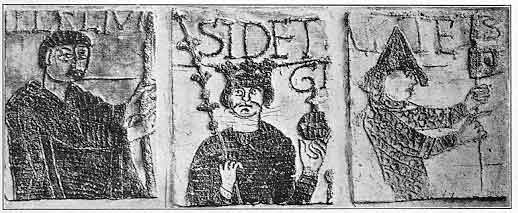 |
FIG 40. REDUCED ILLUSTRATION OF THE
ACTUAL APPEARANCE OF THE BAYEUX NEEDLEWORK, SHOWING THE CRUDENESS
OF ITS RENDERING
From a coloured cast made by Charles Stothard. British Museum |
Shirts of mail represented by simple outlines, the various
types distinguished by arrangements of dots, rings, and lines;
conical fighting helmets resembling triangles balanced on the
heads of the warriors; spears that look like darning needles,
and other weapons, the true meaning and use of which can only
be a matter of guesswork; such conventions serve this authority
(Fig. 40). Yet, much that is of the greatest interest and importance
in the study of armour and arms can be learnt from this crude
work: though we have constantly to bear in mind that this needlework
roll has been subject to restoration on no fewer than four occasions,
the first of which occurred late in the XVIIth century.
In the case of the Norman warrior, we will not, imitating our
procedure with his Saxon brother, consider the habiliments of
the rank and file first; [33]
but we will pick out and dissect the armour and weapons of some
of the principal figures in the famous roll and seek to trace
the likeness in their accoutrements to that of those appearing
in other existing documents of the same period, by this comparison
endeavouring to determine the actual aspect and method of manufacture
of Norman armaments.
We will however keep to the order in which we have already
discussed the armaments of the Saxon warrior - that is, first
the body armour, then the helmet and the principal weapon, the
sword, and finally the secondary weapons, such as the lance, the
spear, the mace, and the bow.
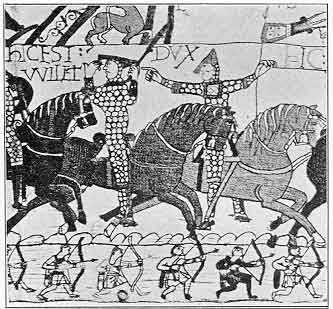 |
FIG. 41. WILLIAM THE CONQUEROR
His eleventh representation on the Bayeux needlework, showing
his helmet thrown back on his head to assure his followers of
his presence. |
First look at the representation of Duke William himself -
he appears eleven times on the roll. The most interesting of these
figures is that in the scene where, to assure his followers of
his presence, the Duke has thrown back his conical helmet with
its broad nasal guard, holding it raised with his right hand,
while with his left he brandishes a curious mace that resembles
nothing more closely than a stout wooden cudgel (Fig. 41). The
rambling letters of the background tell you that HIC EST WILEL'
DVX. With the exception of the horseman in front of him, William
is the the only warrior represented in full mail; by that is meant
that he and his companion have the additional mail covering of
chausses for their lower limbs, differing therein from
the other knights who are defenceless below the knee save for
leather thongs or the equivalent. His hauberk descends below the
knee, its skirt slit back and front for convenience in riding,
in a fashion that has bred a controversy as to whether the hauberk
ended below the waist, as a pair of short breeches, and was, in
fact, cut like a modern bathing suit. But on reference to another
part of the Bayeux roll we see weapons and armour being carried
to the ships. None of the hauberks, which are clearly drawn from
a full-face view, are so fashioned [34]
below, and we can therefore take it that the appearance lent to
many of the hauberks worn by the knights was not due to their
really encircling the legs of the wearer, but to the incapacity
of the embroiderer or draughtsman in indicating the hauberk clinging
to the legs (Fig. 42).
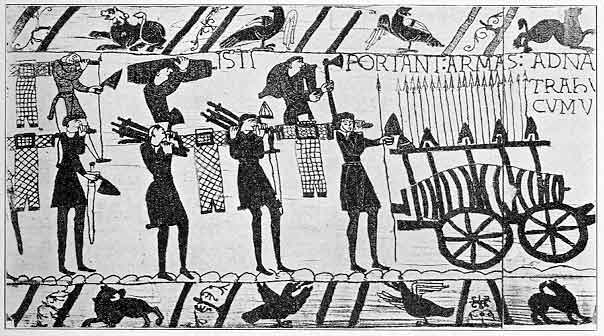 |
FIG. 42. THE BAYEUX NEEDLEWORK
Soldiers carrying hauberks, helmets and swords to the ships,
likewise spears or javelins and apparently liquid rations |
An instance of the simple form of the long hauberk (though
the fact does not bear great weight in this argument) is to be
seen in some of the chain mail shirts which were captured from
the Soudanese after the battle of Omdurman; many of these shirts
were certainly as long as those worn by the Norman invaders, but
none was joined round the legs, although the Soudanese method
of fighting on horseback and much of Soudanese military apparel
bear a very close resemblance to those of the Norman warrior of
the XIth century.
Mr. Albert Way, in his glossary for the second edition of Meyrick's
"Critical Inquiry," applies to this imaginary combination
garment of hauberk and breeches the name haubergeon as opposed
to the simple shirt or hauberk. But in this he must surely be
in error, for the name is a diminutive of hauberk, and so could
not well be a term to describe these very long hauberks.[35]
If we look carefully at the selected illustration of the Conqueror
from the Bayeux needlework, we can see the armoured sleeves of
another garment issuing through the wide arm-holes of the hauberk;
these in the loose drawing of the time are represented as possessing
exactly the same annulated surface as the hauberk itself. May
they not be the sleeves of the small under-hauberk that might
correctly be called the haubergeon?
The hauberks have a square opening at the neck, whilst at about
the height of the chest we see on most of the shirts a rectangular
reinforcement edged with some other material. This, in the Duke's
hauberk, is not present, but it seems that the hood of mail issues
from under the top of his hauberk. Might not this mail hood and
the under sleeves appearing from beneath the hauberk be part and
parcel of the same under protective garment?
We have discussed the probable shape of the Norman hauberk,
but we come now to a far more difficult problem - the method of
its construction and the material used. Up to this point the word
mail has been used to denote the pliant, protective material of
the hauberk, not necessarily interlinked mail. From the divers
ways of illustrating it, it would appear that various forms of
mail are intended to be indicated. That pioneer in the study of
armour, Sir Samuel Rush Meyrick, in his " Critical Inquiry,"
classifies the various styles represented as "tegulated,"
"trellised," mascled," " banded," etc.,
scale-mail being already recognized by antiquaries in the lorica
squamata of the Romans. But after most carefully studying
his views we cannot help agreeing with the late Mr. W. Burges,
that these many names are but so many guesses at the materials
indicated by the old artists, and that, whatever convention their
brush or needle may follow, it is, as a rule, chain-mail that
they would show us.
In the Bayeux needlework, where the figures are small and the
material coarse, the embroiderer had no better method of representing
interlinked mail than by indicating rings on the surface of the
coat. Many writers have imagined from this that the armour was
actually composed of rings sewn on to a foundation of some kind
of linen, cloth, or leather. But such a protection would be of
the poorest quality; it might withstand a sword-cut, but would
be incapable of stopping a thrust from any weapon - the rings
would immediately be forced apart. It may also be asked how long
the stitches attaching the rings would last when the iron had
begun to rust? Let us therefore be bold and assert that the mail
hauberk of the Norman, conventionally represented by rings, by
dots, or by scale-like marks, was none other than the ordinary
interlinked chain mail, as we know it, of the [36]
XVth and XVIth centuries. It may, of course, have varied very
considerably in the size of its links; we see several sizes of
rings illustrated in the Bayeux roll, but we think they all represent
mail of the same construction, of the same make as the ring-byrnie
of the Anglo-Saxon.
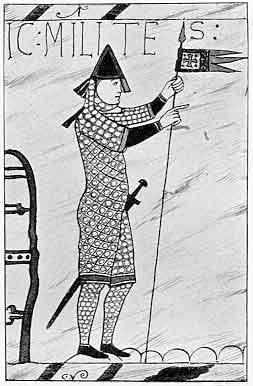 |
FIG. 43. WILLIAM THE CONQUEROR
His eighth representation on the Bayeux needlework; showing the
conventional rendering of chain mail in two ways upon the same
hauberk. - Note the clear outline of his sword hilt. |
Two instances of mail differently pictured, but necessarily
of the same kind, we can here illustrate. First in the Bayeux
roll, in the eighth representation of the Conqueror (Fig. 43),
where he is standing unmounted. The mail of his hauberk is here
represented by a cross hatching, into the trellis of which are
inserted the usual circles. This is on his body and right leg;
but the part of the hauberk that falls over his left leg shows
a different treatment, circles alone without the cross hatching.
Therefore, unless his hauberk had a longitudinal half of one kind
of mail and another half of a different kind, which of course
is entirely improbable, we have proof positive of two conventional
fashions of representing the same mail shirt upon one figure.
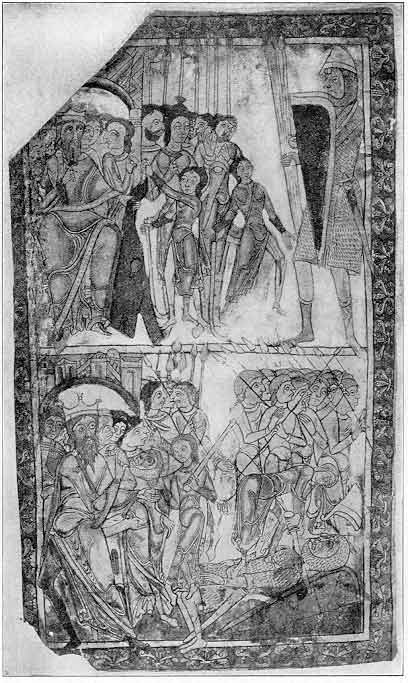 |
FIG. 44.
MS. Nero C. iv, about 1125, British Museum. In the upper picture
the hauberk of Goliath shown in two conventional ways, though
of necessity the same mail shirt. In the lower picture note the
wheel pommels of the swords and formation of spear and lance
heads [38] |
For a second instance of this looseness of drawing, we have
but to look at the illustration (Fig. 44) chosen from the Cotton
MS. Nero, C. 4, about 1125. We see in the upper portion of the
page David and Goliath. On the left of the picture David has driven
the stone from his sling into the forehead of Goliath; on the
right of the picture David, after the death of his opponent, hands
Goliath's hauberk of mail to Saul. As it stands to reason that
the hauberk worn by Goliath must be the same as the one offered
by David to Saul, and as the former has only just killed the giant,
it is instructive to see that the same shirt of mail, illustrated
twice in the same picture, is represented after two distinct conventions:
worn on the giant it is represented by a series of small S-shaped
markings; stripped from his body and held in the hand of Saul,
it is shown with small circles evenly placed over the whole shirt.
These two illustrations are here described at some length for
the lesson [37] they teach as to
the extreme looseness of conventional mail-illustration is most
instructive.
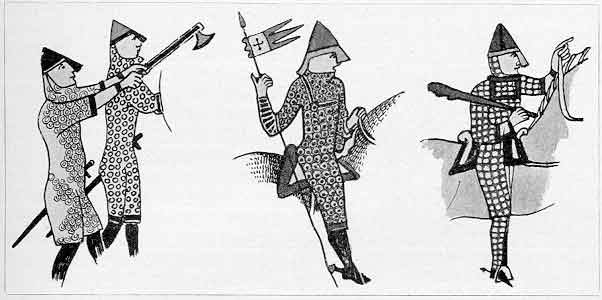 |
FIG. 45. FROM THE BAYEUX NEEDLEWORK
Four conventional ways of what the author believes to be the
ordinary hauberks of linked chain mail |
When, however, we see entirely different methods used in illustrating
defensive coats or hauberks, all of which are chosen from the
same Bayeux needlework (Fig. 45), we must stop to consider whether
they are intended to distinguish real divergences from the conventionality
of rendering.
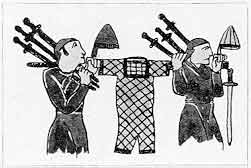 |
FIG. 46. FROM THE BAYEUX NEEDLEWORK
This might be a quilted defensive garment of the brigandine type
[40] |
However, when shirts are rendered as in our next illustration
(Fig. 46), they were of the other types that were in use, which
can safely be said to differ entirely in their construction from
the true chain mail shirt, and must therefore be placed in a different
category. Doubtless they were those quilted coats of linen which
in later years would be known as the pourpoint or later still
jacks. They might also be made of leather, or be composed of scales
of copper, iron, or horn sewn between layers of pliable material.
A certain similarity in the fashion of the armour prevails
throughout, though in many cases the degree of protection afforded
by the armaments varies considerably. One knight will be seen
with his legs encircled in thongs; one with creaseless legs as
if bare, though they were doubtless covered with cloth or leather:
some appear in sleeveless hauberks and some [39]
with bare arms; others again are distinguished by wearing
spurs or by riding bareheaded.
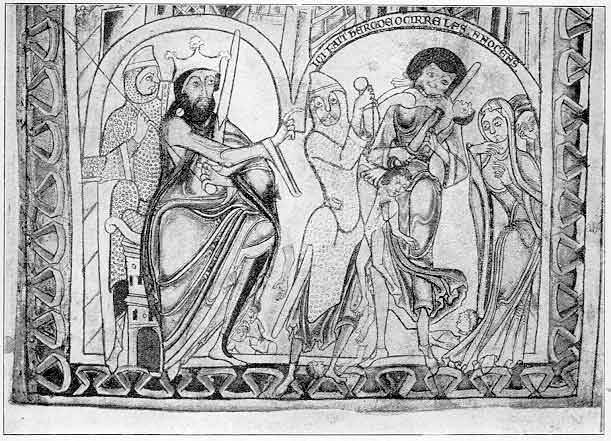 |
FIG. 47. MASSACRE OF THE INNOCENTS
MS. Nero, C. iv, about 1125, British Museum showing a different
type of hauberk, the sword worn on the right-hand side, and a
later form of conical helmet [41] |
In the Cotton MS. Nero C. iv, which, as we have already stated,
may be assigned to the last years of the XIth or early years of
the XIIth century, we note a figure taken from a group entitled
"Massacre of the Innocents" (Fig. 47). Here the hauberk
is of different form from those depicted on the Bayeux needlework;
it is not slit up at the front and back, but at the sides. Through
the right-hand opening issues the sword scabbard, the top of which
passes through a special aperture in the waist of the hauberk.
A warrior wearing such a hauberk would find it impossible to straddle
a horse, so we must take it that it was intended solely for use
on foot. It will also be noticed that the sleeves of this hauberk
reach almost to the wrist. The long pleated tunic beneath shows
no signs of the gambeson.
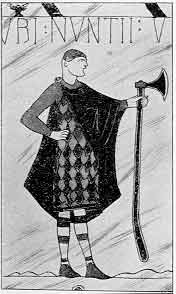 |
FIG. 48. FROM THE BAYEUX NEEDLEWORK
Guy, Count of Ponthieu, in a scaled garment, carrying the Danish
or Norman axe. The head shown almost duplicates the example illustrated
(page 26, Fig. 32) [42] |
Up to this point we have barely mentioned what is called scale
armour. We have spoken of it as the leather byrnie of the Anglo-Saxons.
But scale armour has been known in all ages and by every nation.
In the Bayeux needlework we see the figure of Guy, Count of Ponthieu
(Fig. 48), in a very clearly delineated hauberk of this fashion,
the scales of which, from their magnitude, we should imagine to
be of leather rather than of metal. It will be noticed that it
is a sleeveless hauberk, for doubtless scales of such size would
restrict the free swing of the arms. The scale tunic was the most
popular defence of the soldiery, even after Saxon times, owing
to the simplicity with which the scales, of iron, copper, horn,
bone, or even of horse's hoof, could be cut out and sewn on to
a foundation of leather or cloth. These scales were of all shapes;
some with the edges rounded and placed to overlap like tiles;
often in groups of two; while in other instances each plate was
rectangular, a fashion which, when displayed as we see it on one
of the warriors of the close of the XIth century, drawn in Herr
Hefner-Alteneck's Trachten, part i, Plate XII, gives a very excellent
illustration of what Sir Samuel Meyrick will call "tegulated"
armour. We have not reproduced this plate, for we confess to a
feeling of uneasiness in doing so as not having seen the original;
for judged by certain of its details, as for instance its completely
"tegulated" [40] legs,
feet and gauntlets, it would seem of a later date. It has, however,
been accepted by some of the first authorities as being truly
an example of the period, so we have alluded to it. It is stated
that in the original miniature painting upon vellum the armour
is silvered, which would be meant to represent iron.
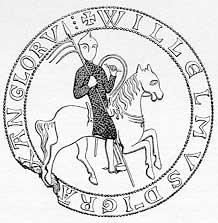 |
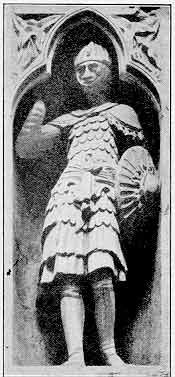 |
FIG. 49. THE GREAT SEAL OF WILLIAM
II
Construed by John Hewitt. From Ancient Armour and Weapons in
Europe, by John Hewitt [42] |
FIG. 50. SCALE BODY ARMOUR
From a statue of the early part of the XIIIth Century. Reims
Cathedral [42] |
The figure expressed by the Great Seal of William II gives
us a good example of a scale suit as worn by persons of high rank
at this period. In this instance the scales might even be of gilded
iron or bronze. The hauberk reaches to the knee and is clearly
of simple form, split up front and back to facilitate riding.
As far as it is possible to see, it has long sleeves reaching
to the wrist (Fig. 49). For an excellent illustration of the military
attire of scale armour, though of rather later date, we illustrate
one [41] of the statues of soldiers
from the facade of Reims Cathedral (Fig. 50). In all probability
the date of this statue is of the first quarter of the XIIIth
century, but the large overlapping scales are remarkable, for
they show but a very slight defensive advance from those depicted
as worn by Guy, Count of Ponthieu.
Return to site home page
~ framed ~ unframed
 F the English king had held his
own on the hill; if William's body and not Harold's had been dragged
that October morning to a grave under the rocks of the Sussex
shore, our tale of the armourer's changing fashions would yet
go on. For a generation, for two generations or three, those old
English who never loved change would have followed their fathers'
customs, riding to the battlefield, but lighting down to fight
with swinging weapons, Englishmen elbow to elbow. Yet we cannot
doubt that, in the end, the English knight would be as the French
knight, as the knights of Flanders or Almain, a horseman fully
armed for the battle of horsemen.
F the English king had held his
own on the hill; if William's body and not Harold's had been dragged
that October morning to a grave under the rocks of the Sussex
shore, our tale of the armourer's changing fashions would yet
go on. For a generation, for two generations or three, those old
English who never loved change would have followed their fathers'
customs, riding to the battlefield, but lighting down to fight
with swinging weapons, Englishmen elbow to elbow. Yet we cannot
doubt that, in the end, the English knight would be as the French
knight, as the knights of Flanders or Almain, a horseman fully
armed for the battle of horsemen.









